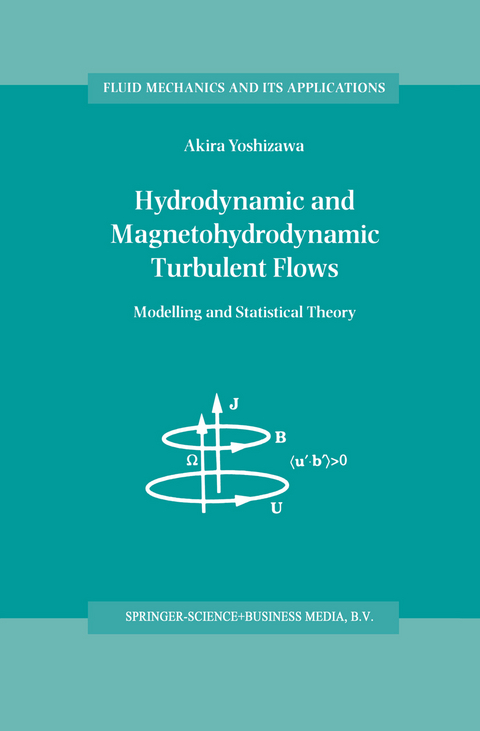
Hydrodynamic and Magnetohydrodynamic Turbulent Flows
Modelling and Statistical Theory
Seiten
2011
|
Softcover reprint of hardcover 1st ed. 1998
Springer (Verlag)
978-90-481-5090-8 (ISBN)
Springer (Verlag)
978-90-481-5090-8 (ISBN)
TUrbulence modeling encounters mixed evaluation concerning its impor tance. The estrangement between the physics community and the turbulence modeling is further enhanced by the fact that the latter is founded on a weak theoretical basis, compared with the study of small-scale turbulence.
TUrbulence modeling encounters mixed evaluation concerning its impor tance. In engineering flow, the Reynolds number is often very high, and the direct numerical simulation (DNS) based on the resolution of all spatial scales in a flow is beyond the capability of a computer available at present and in the foreseeable near future. The spatial scale of energetic parts of a turbulent flow is much larger than the energy dissipative counterpart, and they have large influence on the transport processes of momentum, heat, matters, etc. The primary subject of turbulence modeling is the proper es timate of these transport processes on the basis of a bold approximation to the energy-dissipation one. In the engineering community, the turbulence modeling is highly evaluated as a mathematical tool indispensable for the analysis of real-world turbulent flow. In the physics community, attention is paid to the study of small-scale components of turbulent flow linked with the energy-dissipation process, and much less interest is shown in the foregoing transport processes in real-world flow. This research tendency is closely related to the general belief that universal properties of turbulence can be found in small-scale phenomena. Such a study has really contributed much to the construction of statistical theoretical approaches to turbulence. The estrangement between the physics community and the turbulence modeling is further enhanced by the fact that the latter is founded on a weak theoretical basis, compared with the study of small-scale turbulence.
TUrbulence modeling encounters mixed evaluation concerning its impor tance. In engineering flow, the Reynolds number is often very high, and the direct numerical simulation (DNS) based on the resolution of all spatial scales in a flow is beyond the capability of a computer available at present and in the foreseeable near future. The spatial scale of energetic parts of a turbulent flow is much larger than the energy dissipative counterpart, and they have large influence on the transport processes of momentum, heat, matters, etc. The primary subject of turbulence modeling is the proper es timate of these transport processes on the basis of a bold approximation to the energy-dissipation one. In the engineering community, the turbulence modeling is highly evaluated as a mathematical tool indispensable for the analysis of real-world turbulent flow. In the physics community, attention is paid to the study of small-scale components of turbulent flow linked with the energy-dissipation process, and much less interest is shown in the foregoing transport processes in real-world flow. This research tendency is closely related to the general belief that universal properties of turbulence can be found in small-scale phenomena. Such a study has really contributed much to the construction of statistical theoretical approaches to turbulence. The estrangement between the physics community and the turbulence modeling is further enhanced by the fact that the latter is founded on a weak theoretical basis, compared with the study of small-scale turbulence.
1 Introductory Remarks.- 2 Hydrodynamic Equations.- 3 Small-Scale Turbulence.- 4 Conventional Turbulence Modeling.- 5 Subgrid-Scale Modeling.- 6 Two-Scale Direct-Interaction Approximation.- 7 Markovianized One-Point Approach.- 8 Compressible Turbulence Modeling.- 9 Magnetohydrodynamic Turbulence Modeling.- 10 Global Magnetic Fields in Turbulent Motion.
| Erscheint lt. Verlag | 22.1.2011 |
|---|---|
| Reihe/Serie | Fluid Mechanics and Its Applications ; 48 |
| Zusatzinfo | XIII, 416 p. |
| Verlagsort | Dordrecht |
| Sprache | englisch |
| Maße | 155 x 235 mm |
| Themenwelt | Naturwissenschaften ► Geowissenschaften ► Geophysik |
| Naturwissenschaften ► Physik / Astronomie ► Astronomie / Astrophysik | |
| Naturwissenschaften ► Physik / Astronomie ► Atom- / Kern- / Molekularphysik | |
| Naturwissenschaften ► Physik / Astronomie ► Elektrodynamik | |
| Naturwissenschaften ► Physik / Astronomie ► Mechanik | |
| Naturwissenschaften ► Physik / Astronomie ► Strömungsmechanik | |
| Technik ► Maschinenbau | |
| ISBN-10 | 90-481-5090-6 / 9048150906 |
| ISBN-13 | 978-90-481-5090-8 / 9789048150908 |
| Zustand | Neuware |
| Informationen gemäß Produktsicherheitsverordnung (GPSR) | |
| Haben Sie eine Frage zum Produkt? |
Mehr entdecken
aus dem Bereich
aus dem Bereich
How Numerical Models Revealed the Secrets of Climate Change
Buch | Hardcover (2020)
Princeton University Press (Verlag)
CHF 59,95
Space, Time, and Motion
Buch | Hardcover (2022)
Dutton (Verlag)
CHF 36,15


